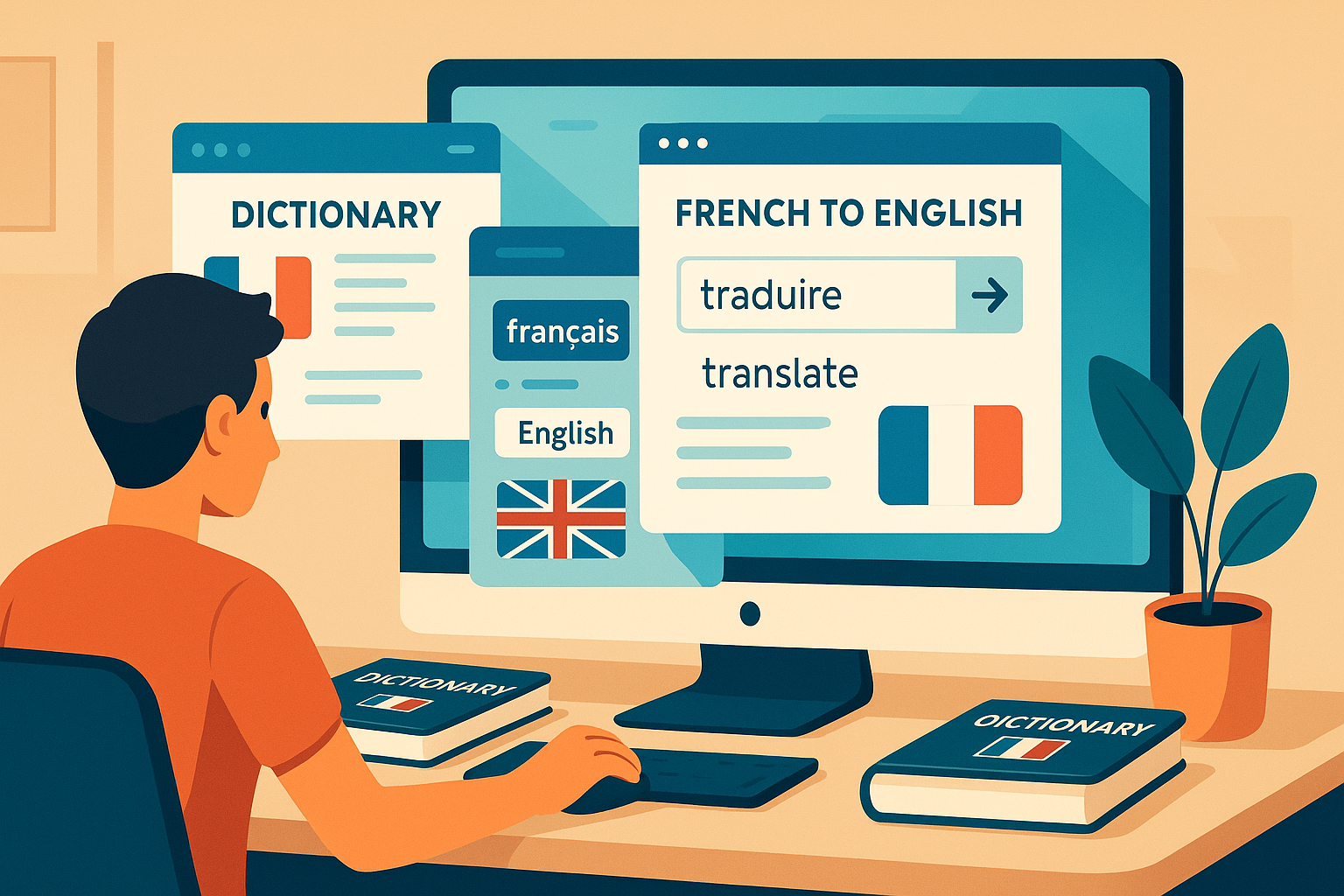Best online dictionaries for French to English translation — beyond WordReference (A1–C1)
While WordReference serves as many learners’ first dictionary, professional translators and advanced students rely on a diverse toolkit of specialized resources. This comprehensive guide explores the best French-English dictionaries and translation tools available online, from monolingual French references to context-based translators, helping you choose the right resource for every situation.

Why you need more than WordReference
WordReference provides excellent service for quick lookups and forum discussions about nuanced translations. However, serious French learners quickly discover its limitations: incomplete entries for specialized vocabulary, occasional outdated examples, limited contextual information, and heavy reliance on user-generated forum content that varies in accuracy. Professional translators rarely use WordReference as their primary resource for precisely these reasons.
Different dictionary types serve different purposes throughout your French learning journey. Bilingual dictionaries help beginners understand new words quickly, but they cannot capture the full semantic range that monolingual French dictionaries reveal. Context-based translation tools show real-world usage patterns that traditional dictionaries miss. Technical dictionaries provide specialized terminology absent from general resources. Building a personal dictionary toolkit tailored to your learning level and goals dramatically improves translation accuracy and comprehension depth.
The most effective approach combines multiple resources strategically. Start with context-based tools to see authentic usage, verify with authoritative monolingual sources for nuance, cross-reference with bilingual dictionaries for English equivalents, and consult specialized resources for technical or domain-specific vocabulary. This multi-layered verification process prevents the common mistakes that single-source reliance produces.
Context-based translation tools — see words in action
Linguee — The gold standard for contextual translation
Best for: Seeing how native speakers actually use words and phrases in authentic contexts
How it works: Linguee searches millions of bilingual texts (EU documents, corporate websites, academic papers) to show you real-world examples of words and phrases with their translations in context. Unlike traditional dictionaries providing isolated definitions, Linguee reveals actual usage patterns across diverse professional and formal contexts.
Why translators love it: You see not just what a word means but how people actually use it in sentences. This contextual approach prevents awkward literal translations and reveals appropriate register, collocations, and idiomatic usage.
Perfect for: Translating professional documents, understanding idiomatic expressions, verifying appropriate usage in formal contexts, learning collocations
Example search: “faire le point”
What you see: Dozens of bilingual sentence pairs from official documents showing this expression translated as “take stock,” “review the situation,” “assess progress” depending on context—revealing nuances a simple dictionary entry misses.
Reverso Context — Conversational and informal usage
Best for: Understanding how words work in everyday conversation and informal writing
How it works: Reverso Context searches movie subtitles, TV shows, and informal texts to provide conversational examples. This complements Linguee’s formal focus by showing colloquial usage, slang variations, and spoken language patterns.
Unique features: Audio pronunciation for many examples, synonyms in context, conjugation tables integrated with example sentences, ability to see usage frequency patterns
Perfect for: Learning conversational French, understanding dialogue in French Netflix shows, grasping informal registers, preparing for casual conversations
⚠️ Reverso caution: Because Reverso includes subtitle translations, some examples contain errors or overly literal translations. Always verify critical translations with authoritative sources.
Authoritative monolingual French dictionaries
CNRTL (Centre National de Ressources Textuelles et Lexicales)
Best for: Deep understanding of French words including etymology, historical usage, and complete semantic range
How it works: This comprehensive academic resource provides exhaustive entries including etymology, historical evolution, literary citations, usage across centuries, phonetic transcriptions, and detailed semantic analysis. CNRTL represents the most authoritative French language reference available online.
Why advanced learners need it: Monolingual dictionaries force you to think in French rather than constantly translating to English. CNRTL reveals subtle distinctions between near-synonyms that bilingual dictionaries cannot capture. Understanding words through French definitions rather than English approximations deepens linguistic intuition.
Perfect for: B2-C1 learners, understanding nuanced differences between synonyms, academic writing, literary analysis, etymology research
🇫🇷 FR — Example: Looking up “flâner” in CNRTL reveals its historical evolution from medieval French, literary citations from Baudelaire, subtle distinctions from similar verbs like “se promener” or “errer,” and cultural context about the flâneur as urban archetype—information completely absent from simple bilingual entries.
Larousse en ligne
Best for: Clear, concise French definitions with excellent example sentences
How it works: Larousse provides straightforward French definitions, synonyms, antonyms, and usage examples in accessible language. Less academic than CNRTL, Larousse balances comprehensiveness with readability, making it ideal for intermediate learners transitioning to monolingual resources.
Unique features: Bilingual section for quick English equivalents, pronunciation guides, conjugation tables, difficulty level indicators, thematic word lists
Perfect for: A2-B1 learners ready for monolingual dictionaries, quick reference for synonyms, verifying appropriate usage contexts
Le Petit Robert (subscription required for full access)
Best for: Contemporary French usage with excellent example sentences from modern sources
How it works: Le Robert provides detailed entries focusing on contemporary usage, with examples drawn from recent literature, journalism, and everyday speech. The digital version includes audio pronunciations, word history, and usage notes addressing common mistakes.
Worth the cost? For serious students and professionals, yes. Le Robert’s depth, currency, and reliability justify the subscription cost. However, free alternatives like CNRTL and Larousse provide comparable quality for learners on budgets.
Specialized and technical dictionaries
Termium Plus (Government of Canada)
Best for: Technical, legal, medical, and official terminology
How it works: This Canadian government resource provides authoritative translations for specialized vocabulary across dozens of fields including law, medicine, engineering, finance, and administration. Entries include usage notes, context, and field-specific definitions ensuring precision in professional translation.
Perfect for: Business French, technical translation, legal documents, medical terminology, government communications
IATE (Interactive Terminology for Europe)
Best for: EU institutional terminology and multilingual technical vocabulary
How it works: IATE aggregates terminology from EU institutions across 24 languages, providing verified translations for technical, legal, and administrative terms. Particularly valuable for understanding French as used in international organizations and European contexts.
Perfect for: International relations, European business contexts, diplomatic vocabulary, legal and administrative terminology
Pronunciation and audio resources
Forvo — Pronunciation by native speakers
Best for: Hearing authentic pronunciation from multiple native speakers
How it works: Users submit audio pronunciations of words and phrases. You can hear the same word pronounced by speakers from different French regions (Paris, Quebec, Belgium, Switzerland), revealing regional variation and helping you choose which accent to model.
Why it matters: Understanding French pronunciation patterns requires exposure to actual native speech, not synthesized voices. Forvo provides this authentic input across regional varieties.
Collins French Dictionary (online version)
Best for: IPA transcriptions and British English translations
How it works: Collins provides detailed IPA transcriptions for pronunciation guidance, comprehensive verb conjugations, and British English translations (WordReference defaults to American English). The audio pronunciations use professional voice actors with clear articulation.
Perfect for: Learners in UK contexts, IPA learners, detailed grammatical information
Strategic dictionary selection — which tool when
For beginners (A1-A2)
Primary tools: WordReference for basic lookups, Larousse bilingual section for quick translations, Reverso Context for example sentences
Strategy: Focus on understanding basic meanings quickly. Use example sentences to see words in context, but don’t worry about subtle nuances yet. Build vocabulary breadth before depth.
Example workflow: Look up “maison” in WordReference → Check Reverso Context for example sentences → Note common phrases like “à la maison” → Practice with simple sentences
For intermediate learners (B1-B2)
Primary tools: Linguee for contextual usage, Larousse monolingual for French definitions, WordReference for quick verification
Strategy: Begin transitioning to monolingual dictionaries for common words while using bilingual resources for new vocabulary. Focus on understanding connotations, register differences, and collocations rather than just basic meanings.
Example workflow: Encounter “dépaysement” in reading → Check Linguee for contextual examples → Read Larousse French definition → Verify understanding with bilingual dictionary → Note usage contexts and collocations
For advanced learners (C1-C2)
Primary tools: CNRTL for deep understanding, Linguee for professional translation, specialized dictionaries for technical vocabulary
Strategy: Use monolingual French dictionaries as primary resources, consulting bilingual dictionaries only for verification. Focus on subtle distinctions between synonyms, etymology that explains current usage, and domain-specific terminology.
Example workflow: Need to translate technical business term → Check Termium Plus for specialized terminology → Verify contextual usage in Linguee → Consult CNRTL for nuanced understanding → Cross-reference with domain experts if critical
Common dictionary mistakes and how to avoid them
Mistake 1: Trusting the first translation without checking context
Many words carry multiple meanings depending on context. The French word “formation” means “training” in business contexts but “formation” (creation/arrangement) in geological contexts. Always verify which meaning applies to your specific situation by checking multiple example sentences in context-based tools like Linguee.
⚠️ False friend alert: Never assume French words resembling English words carry the same meaning. “Actuellement” means “currently” not “actually.” “Rester” means “to stay” not “to rest.” Always verify with false friends resources.
Mistake 2: Ignoring register and formality
Dictionaries often fail to clearly indicate whether words or phrases are formal, informal, slang, or vulgar. A word appropriate for texting friends might be completely inappropriate for professional emails. Use context-based tools to see where and how words actually appear in authentic texts, revealing appropriate usage contexts.
Mistake 3: Relying solely on bilingual dictionaries at advanced levels
Bilingual dictionaries provide approximate equivalents, but many French concepts lack perfect English equivalents. Advanced learners need monolingual French dictionaries to understand words through French explanations rather than imperfect English approximations. This shift from translation thinking to French thinking marks the transition from intermediate to advanced proficiency.
Mistake 4: Not verifying technical or specialized vocabulary
General dictionaries often provide inadequate or incorrect translations for technical terminology. Medical, legal, engineering, and financial vocabulary requires specialized dictionaries like Termium Plus or IATE that understand field-specific meanings and conventions.
Building your personal dictionary workflow
Create a lookup sequence for efficiency
Develop a consistent process for looking up words based on your needs. A typical effective sequence might be: (1) Quick check in Linguee for contextual examples, (2) Verify in Larousse or CNRTL for complete meaning, (3) Confirm pronunciation in Forvo, (4) If technical, check Termium Plus, (5) Note collocations and usage patterns.
💡 Efficiency tip: Bookmark frequently-used dictionaries and learn keyboard shortcuts for each site. The seconds saved per lookup compound to hours over months of study.
Maintain a personal vocabulary notebook
Don’t just look up words—document them systematically. Record the French word, IPA pronunciation, definition in French (from monolingual dictionary), English equivalent, example sentence from Linguee, and personal notes about usage. This active documentation process strengthens retention dramatically compared to passive lookup alone.
Use browser extensions for quick access
Install dictionary browser extensions that allow right-click lookups without leaving the page you’re reading. Extensions for Linguee, WordReference, and Google Translate enable seamless reading of French content with instant clarification when needed, maintaining reading flow while building vocabulary.
Free vs. paid dictionary resources
Excellent free options
The resources discussed in this guide are predominantly free: CNRTL, Larousse (basic version), Linguee, Reverso Context, Termium Plus, IATE, Forvo, and WordReference all offer robust free access. For most learners, these free resources provide everything needed for serious study without requiring subscriptions.
When paid resources justify the cost
Paid subscriptions to Le Petit Robert or Oxford-Hachette French Dictionary provide marginal improvements over free alternatives—primarily in interface design, mobile apps, and offline access rather than content quality. Consider paid resources only if you need offline access for travel or prefer premium user experience. Free resources match or exceed paid alternatives in comprehensiveness and accuracy.
Dictionary comparison summary
| Dictionary | Best For | Learner Level | Cost |
|---|---|---|---|
| Linguee | Contextual examples | A2-C2 | Free |
| CNRTL | Deep French understanding | B2-C2 | Free |
| Larousse | Clear French definitions | A2-B2 | Free (basic) |
| Reverso Context | Conversational usage | A1-B1 | Free |
| WordReference | Quick lookups | A1-B1 | Free |
| Termium Plus | Technical vocabulary | B1-C2 | Free |
| Forvo | Pronunciation | A1-C2 | Free |
| Le Robert | Contemporary usage | B1-C2 | Paid |
Beyond dictionaries — complementary resources
Etymology resources for deeper understanding
Understanding word origins illuminates current meanings and helps remember vocabulary. The “Dictionnaire étymologique” section in CNRTL provides comprehensive etymological information. For example, knowing that “flâner” evolved from Old Norse “flana” (to wander aimlessly) reinforces its meaning and distinguishes it from purposeful walking.
Corpus linguistics tools
Advanced learners benefit from corpus tools like the “Corpus de français parlé parisien” which show frequency data, collocation patterns, and authentic usage statistics. These tools reveal which words and phrases native speakers actually use versus textbook vocabulary that sounds dated or unnatural.
Regional variation resources
French varies significantly across France, Quebec, Belgium, Switzerland, and Africa. Resources like the “Dictionnaire québécois” or “Dictionnaire suisse romand” explain regional vocabulary differences. Understanding that “dépanneur” means convenience store in Quebec but repair person in France prevents confusion in regional contexts.
Study glossary — dictionary terminology
| FR | IPA | EN |
|---|---|---|
| Dictionnaire | /diksjɔnɛʁ/ | Dictionary |
| Définition | /definisjɔ̃/ | Definition |
| Traduction | /tʁadyksjɔ̃/ | Translation |
| Synonyme | /sinɔnim/ | Synonym |
| Antonyme | /ɑ̃tɔnim/ | Antonym |
| Étymologie | /etimɔlɔʒi/ | Etymology |
| Prononciation | /pʁɔnɔ̃sjasjɔ̃/ | Pronunciation |
| Exemple | /ɛɡzɑ̃pl/ | Example |
| Contexte | /kɔ̃tɛkst/ | Context |
| Registre | /ʁəʒistʁ/ | Register (formal/informal) |
| Locution | /lɔkysjɔ̃/ | Expression/Phrase |
| Faux ami | /fo zami/ | False friend |
Authoritative references
- CNRTL — most comprehensive French language resource online.
- Larousse — authoritative French dictionary and encyclopedia.
- Linguee — context-based translation with authentic examples.
- Termium Plus — Government of Canada terminology database.
Learn French with Roger, Native French Tutor
Expert instruction with proven teaching methods. Personalized lessons tailored to your goals from A0 to C1.
Weekly Lessons with Roger
Learn with Roger, a native French tutor. Structured curriculum from beginner to advanced.
- Native French speaker from France
- All levels (A0-C1) supported
- Personalized curriculum
- Proven teaching methodology
Trial Lesson with Roger
Experience Roger’s teaching method with a 25-minute trial session. Perfect to get started.
- 25 minutes with Roger
- Level assessment included
- Personalized learning roadmap
- No commitment required
A1 Foundations Guide
Complete beginner’s guide created by Roger. Structured lessons with native pronunciation.
- Step-by-step A1 curriculum
- Audio by native French speaker
- Practice exercises included
- Learn at your own pace
Continue Learning
Check out these related articles

Best way to learn French for English speakers — what actually works (A1–C1)
Discover the most effective methods for English speakers learning French, including proven strategies that leverage your native language advantages, avoid…

Exploring Montmartre culture (A1–B1) — art, cafés, viewpoints
Learn A1–B1 French for Montmartre: polite greetings, café ordering, directions, art talk, and viewpoint tips—bilingual lines with IPA and a…

French news phrases (A1–B1) — read headlines with confidence
Decode French headlines and short news clips with simple A1–B1 phrases, clear IPA, and practical strategies for reading fast, real-world…
👋 Join Our Community
Follow us for daily tips, pronunciation tricks, and free resources
👍 Follow on Facebook